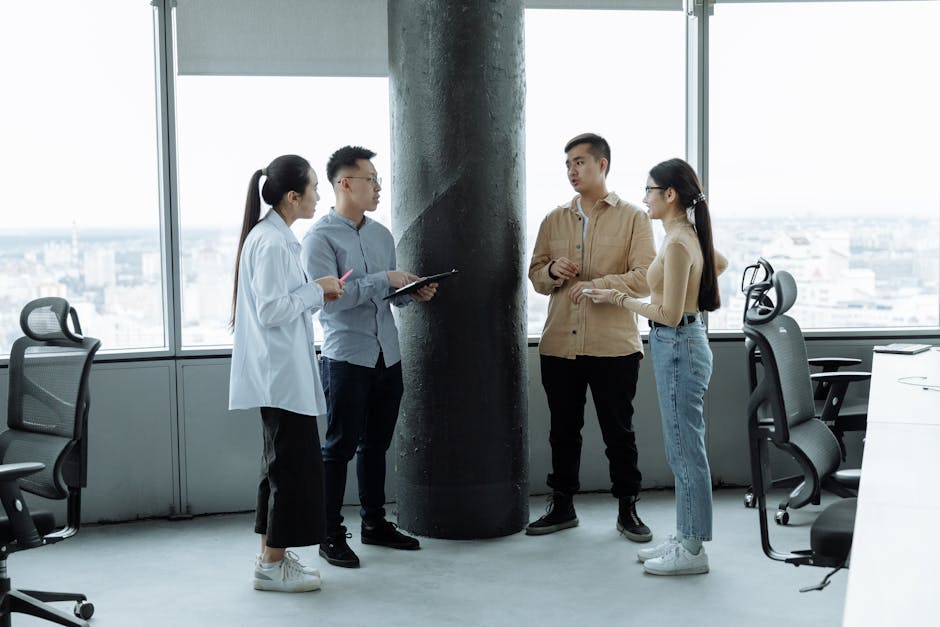Office Environment Improvement Solutions: Create a Better Workplace
Creating a productive and positive office environment is more than just arranging desks and chairs. It involves understanding the needs of employees, optimizing workflows, and fostering an atmosphere that promotes creativity and collaboration. A well-designed workspace not only improves job satisfaction but can also boost overall performance and reduce stress levels.

With changing workplace dynamics and technological advancements, the concept of an ideal office has evolved, encompassing factors like ergonomic furniture, adequate lighting, and even the inclusion of wellness programs.
Prioritizing Ergonomics for Employee Comfort
Ergonomics plays a crucial role in shaping an efficient office environment. Poorly designed workspaces can lead to discomfort, fatigue, and even long-term health issues like musculoskeletal disorders. To combat these challenges, businesses should invest in ergonomic furniture such as adjustable chairs, sit-stand desks, and monitor arms.
Providing employees with adjustable chairs that support proper posture can significantly reduce back pain. Sit-stand desks offer flexibility by allowing users to alternate between sitting and standing positions throughout the day, which studies have shown can improve energy levels and focus (ncbi.nlm.nih.gov).
An ergonomic workplace doesn’t stop at furniture. Keyboard trays, wrist supports, and anti-fatigue mats are other additions that enhance comfort. Offering a variety of options allows employees to customize their workstations based on personal needs.
Lighting: More Than Just Brightness
Lighting is a fundamental yet often overlooked aspect of office design. Poor lighting can lead to eye strain, headaches, and reduced productivity. On the other hand, a well-lit environment can positively impact mood and efficiency.
Natural light is ideal for any workspace as it promotes better mental health and increases alertness. Offices should maximize windows or consider installing skylights to allow sunlight to flow freely. Where natural light is insufficient, LED lighting is an excellent alternative due to its energy efficiency and ability to mimic daylight.
- Consider task lighting for focused work areas.
- Avoid harsh fluorescent lights that cause glare.
- Implement dimmers or adjustable lighting solutions for flexibility.
These adjustments ensure that employees have adequate illumination tailored to different tasks without compromising comfort.
The Impact of Office Layout on Collaboration
The physical arrangement of an office significantly influences communication and teamwork among employees. Open-plan offices encourage interaction but may not suit tasks requiring high concentration. A hybrid layout combining open spaces with private rooms offers a balanced solution.
Flexible seating arrangements are becoming increasingly popular as they allow teams to reconfigure spaces according to project needs. Adding communal areas such as lounges or breakout zones fosters informal discussions that often spark innovative ideas.
An efficient layout also considers the flow of movement within the office. Creating clear pathways reduces congestion while ensuring easy access to shared resources like printers or storage units.
Incorporating Wellness Initiatives
An office environment promoting employee well-being goes beyond physical comfort, it considers mental health as well. Wellness programs like yoga sessions, meditation corners, or fitness challenges show employees that their holistic health matters.
Simple changes such as providing access to healthy snacks or installing water dispensers encourage healthier choices during work hours. Quiet rooms where employees can decompress offer much-needed relief from high-pressure tasks.
A study published by jstor.org highlights how workplaces prioritizing wellness see lower absenteeism rates and higher productivity levels, clear indicators of the long-term benefits these initiatives bring.
Technology Integration for Enhanced Efficiency
Adopting modern technology solutions is essential for creating an office that keeps pace with contemporary demands. Cloud-based tools enable seamless collaboration among team members regardless of location. Project management software like Trello or Asana streamlines task allocation and progress tracking.
Wireless charging stations eliminate clutter caused by cables while ensuring devices remain powered throughout the day. Smart thermostats maintain optimal temperatures without manual intervention, enhancing comfort during extreme weather conditions.
Implementing technology responsibly ensures it complements rather than disrupts workflows, a key consideration for businesses aiming to optimize their operations effectively.
Sustainability in Office Design
Sustainability is no longer optional, it’s a responsibility organizations must embrace when planning their office environments. Eco-friendly practices benefit both the planet and company image while reducing operational costs over time.
| Sustainable Practice | Benefits |
|---|---|
| Using energy-efficient appliances | Lowers utility bills; reduces carbon footprint |
| Recycling programs | Minimizes waste sent to landfills; promotes employee engagement |
| Sourcing sustainable materials | Enhances durability; supports responsible supply chains |
Personalizing Workspaces for Individual Needs
No two employees work the same way; personalization allows individuals to create environments that best suit their preferences. Providing options like desk plants, family photos, or personalized stationery helps foster a sense of belonging.
This approach extends beyond aesthetics, consider giving employees control over environmental factors like temperature or lighting within their immediate vicinity. Such flexibility demonstrates respect for individual comfort levels while improving job satisfaction.
A thoughtfully designed office environment can transform how people work together toward shared goals. By focusing on ergonomics, lighting, layout optimization, wellness initiatives, technology integration, sustainability practices, and personalization opportunities, companies set themselves up not only for increased productivity but also enhanced employee morale and retention rates over time.
.
